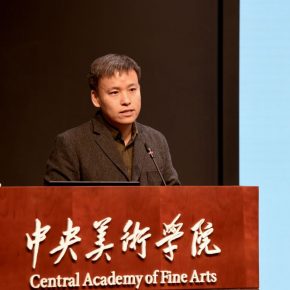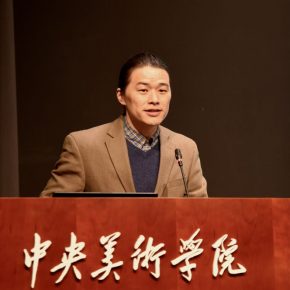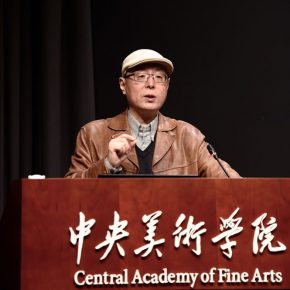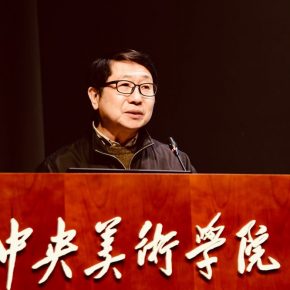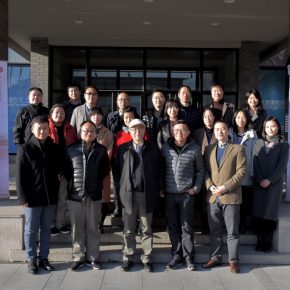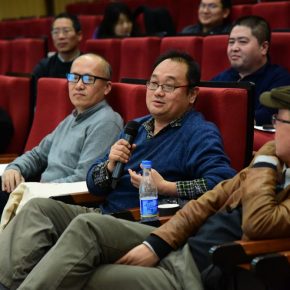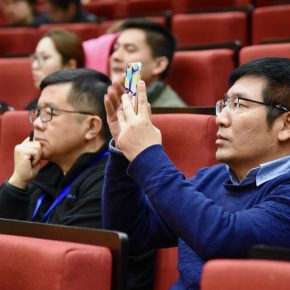
Hosted by the School of Humanities at CAFA, the Second Wang Xun Art History Forum opened at the North District Auditorium on November 24, 2018. The second Wang Xun Art History Forum was centered on the theoretical topic of the “Knowledge Production in Art History”, and more than 20 scholars of different disciplines from different regions were invited to examine the perspectives and visions of research in art history, from their own individual perspectives. While the current issues on the academic research of art history were presented, it has also promoted an exchange and dialogue between the scholars of art history from CAFA and the ones from other institutes, and thus endeavors to develop the discipline.
Wang Xun Art History Forum is a high-level academic forum established by the School of Humanities at CAFA. The chief initiator and planner of the forum, Associate Professor Yu Runsheng from the School of Humanities at CAFA delivered a speech at the opening ceremony of the forum, and briefly reviewed the history of the forum: In 2015, it was the 100th anniversary of the birth of Wang Xun, a well-known Chinese art historian and one of the founders of the Department of Humanities at CAFA, and the young scholars of art history from CAFA proposed to establish a forum named after this ancestor, in order to create an equal and open academic platform, so that art history scholars can unrestrictedly have a discussion in the academic commonwealth. At the opening ceremony, the planner of the forum and Deputy Dean of the School of Humanities at CAFA Huang Xiaofeng delivered a speech to welcome the scholars participating in the forum.
Ahead of the official start of the forum, Professor Li Jun from CAFA gave a speech and talked about the “Knowledge Production in Art History” from the perspective of cross-cultural art history. First of all, Li separated “intercultural” from “multiculturalism.” In his opinion, cultural pluralism is like a “salad bowl”, and a cultural mosaic, so that each culture maintains its own characteristics in the process of mixing. And in the “cross-culture”, a seemingly integrated idea that is regarded from the perspective of difference, and is featured in “interbreeding, mixing, and hybridity”. “Comparativism” can be summarized and regarded as multicultural art history. Li continued to mention that the cross-cultural art history is the art history that transcends boundaries, transcending the boundaries of things, self and culture. In short, it is essentially through re-shaping and re-identifying again and again to find the self of each individual, all countries, and all civilizations. Actually, the projections of the things, the self, and the culture have been accommodated in each individual and the essence. Li also took the exhibitions he curated including “Finding a Homeland at the End of the World: From the Silk Road to the Renaissance” held at the new museum of Hunan Provincial Museum, and “Embracing the Orient and the Occident: When the Silk Road Meets the Renaissance” held at National Museum of China as examples to explain how to use an exhibition to write a cross-cultural art history.
“Knowledge Production in Art History” is both the theme of the Wang Xun Art History Forum, and the title of an interview with Professor Yin Ji’nan from the School of Humanities at CAFA. Professor Yin Ji’nan proposed “Knowledge Generation”, which is an essential concept of Yin’s academic research, based on which he put forward the “knowledge production in art history”, which reflects a dynamic perspective of understanding of art history. The knowledge of art history is both a history and a concept, and also it reflects the interactions between history and concept, and those three interactions are described in the thematic interpretation of the forum: Firstly, many concepts in art history, such as works, artists, genres, styles, technology, are all concepts, and those concepts generate in the interactions of a variety of elements, within a complex historical context; secondly, many methods and theories of art history, different methods and theories reflect different understandings of art history. And in a sense, the formation of the discipline of modern art history is the history of the formation and development of different theories and methods; thirdly, the paradigm of art history research, broadly speaking, art history is a way of understanding the world, and it is necessary to reflect on the overall paradigm of art history research. Also, Professor Yin delivered a speech and explained “What the research of knowledge generation in art history is?” at the closing ceremony of the forum.
In the two-day academic forum, centered on calligraphy, inscriptions, images, symbols, tomb murals, concepts of art history, and the theories and methods of knowledge generation, the scholars delivered speeches in succession, and described the forms of writing and the development in art history, as well as the interactions with the modern discipline of “art history” and other disciplines, from the perspective of knowledge in art history. A detailed review of the forum will be published separately.
Text by Zhang Wenzhi, translated by Chen Peihua and edited by Sue/CAFA ART INFO
Photo courtesy of the organizer
Attachment: The speakers that attended the “Knowledge Production in Art History: the Second Wang Xun Art History Forum” and Their Themes
Xue Lei (School of Arts and Communication, Oregon State University, USA): “The Formation and Production of Calligraphy Knowledge: Taking Wang Xianzhi as an Example”
Guo Weiqi (School of Arts and Humanities, Guangzhou Academy of Fine Arts): “The Ruins of Huang Ting: A Study on the Adoring of the Broken Things”
Xue Longchun (Academy of Cultural Heritage at Zhejiang University, Institute of Humanities and Social Sciences, Peking University): “Stone Tablets of Huang Yi”
Jia Yan (The School of Arts at Peking University): “Why Was a Dustpan Lifted Up? Imaging Tradition and Historical Mystery Hidden in Ashurbanipal’s ‘Monument of the Building’”
Sun Yinggang (Department of History, Zhejiang University): “The Symbol and Image of Buddhist Cakravartiny”
Zheng Yimo (College of Art, Hebei University of Science & Technology): “The Construction of Image and Civilian Art Knowledge – A Study on Images of Porcelain Pillows with Black Decorations Drawn on White Background from the Ceramic Kiln (Cizhou Kiln, Cixian, Hebei) in the Dynasties of Song and Yuan”
Wu Guibing (Department of Archaeology and Cultural Relics, School of History, Nanjing University): “The Horse Legs Dancing – Methods and Essential Thoughts of ‘Reforming’ in the Archaeological Research of Middle Ancient Tomb Archaeological Research”
Li Lin (Department of the History and Theory of Art, LuXun Academy of Fine Arts): “Inheritance and Evolution: Three Issues of the Study on Liaoyang Mural Tomb”
Liu Ping (Academy of Arts & Design, Tsinghua University): “Time-and-Space Narrative Structure of Paintings in the Late Middle Ages”
Peng Yun (Journal of CAFA): “Linear Perspective Was Originated from Brunelleschi in the Narrative and His Experiments”
Zhang Xu (School of Philosophy, Renmin University of China): The Archaeology of Knowledge by Foucault and the Knowledge Generation of Art History”
Zhu Yuanqing (Institute of Thoughts and History of Knowledge, Shanghai University): “From Collation to History”
Yu Runsheng (School of Humanities, CAFA): “It Starts With the Words of ‘M. Ventoux’”
Jiao Lin (Department of the History and Theory of Art, LuXun Academy of Fine Arts): “How Did the Emperor and Empress Worshiping Buddha Become a Classic Piece? – On the Construction of Chinese Buddhist Art History in the Early 20th Century”
Zhu Shuai (School of Journalism and Communication, Peking University): “The History Generation of the Studies on ‘the History of Chinese Calligraphy’ – Centered on Wang Cenbo, Sha Menghai, Sun Yiti, Hu Xiaoshi, Zhu Jia”
Hang Chunxiao (Institute of Fine Arts, China National Academy of Arts): “Guan Liang’s Identity ‘Trap’ and Formal Language: A ‘Traditional’ and ‘Modern’ Cognitive Mechanism in the 20th Century”
Xie Bo (The Center for East Asian Studies at the University of Pennsylvania):
“Queen Mother of the West as a Concept – Taking the Legend System of Queen Mother of the West Appearing in the Tales of Mystery as an Example”
Zhang Mingwei (Department of History, Peking University): “About ‘The ancient etiquette that ministers knelt down to worship the emperor, and then leaving and dancing’, in the Dynasties of Tang and Song”
Wu Ruoming (School of Literature, Nankai University): “Using the Porcelain to Examine a Text: The Formation and Multivariate Reconstruction of the Concept of German Chinoiserie”
Qiu Caizhen (Academy of Arts & Design, Tsinghua University): “‘Lanting Eight Columns’: Generation of the Royal Taste of Calligraphy by the Emperors of Qing”


